Impact of Kara Sea Shelf Water on Seawater Parameters in Subsurface Layer of Laptev Sea
Abstract
1. Introduction
2. Materials and Methods
2.1. Study Area
2.2. Ship-Borne Data
2.3. Ancillary Data
3. Results
3.1. Lena River Discharge, Wind Regime, and Water Circulation
3.2. Chemical Parameter Distributions
3.2.1. Nutrients and AOU in 50–250 m Layer of KS and LS
3.2.2. KS and LS. August- September 2019 and September–October 2024
3.2.3. LS. September 2007, August 2008, and October 2018
4. Discussion
5. Conclusions
Supplementary Materials
Author Contributions
Funding
Data Availability Statement
Conflicts of Interest
References
- Wilson, C.; Wallace, D.W. Using the nutrient ratio NO/PO as a tracer of continental shelf waters in the central Arctic Ocean. J. Geophys. Res-Ocean. 1990, 95, 22193–22208. [Google Scholar] [CrossRef]
- Laukert, G.; Grasse, P.; Novikhin, A.; Povazhnyi, V.; Doering, K.; Hölemann, J. Nutrient and silicon isotope dynamics in the Laptev Sea and implications for nutrient availability in the transpolar drift. Glob. Biogeochem. Cycles 2022, 36, e2022GB007316. [Google Scholar] [CrossRef]
- Gordeev, V.V.; Sidorov, I.S. Concentrations of major elements and their outflow into the Laptev Sea by the Lena River. Mar. Chem. 1993, 43, 33–45. [Google Scholar] [CrossRef]
- Cauwet, G.; Sidorov, I. The biogeochemistry of Lena River: Organic carbon and nutrients distribution. Mar. Chem. 1996, 53, 211–227. [Google Scholar] [CrossRef]
- Peterson, B.J.; Holmes, R.M.; McClelland, J.W.; Vorosmarty, J.V.; Lammers, R.B.; Shiklomanov, A.I.; Rahmstor, S. Increasing river discharge to the Arctic Ocean. Science 2002, 298, 2171–2173. [Google Scholar] [CrossRef]
- Semiletov, I.P.; Pipko, I.I.; Shakhova, N.E.; Dudarev, O.V.; Pugach, S.P.; Charkin, A.N. Carbon transport by the Lena River from its headwaters to the Arctic Ocean, with emphasis on fluvial input of terrestrial particulate organic carbon vs. carbon transport by coastal erosion. Biogeosciences 2011, 8, 2407–2426. [Google Scholar] [CrossRef]
- Vonk, J.E.; Gustafsson, Ö. Permafrost-carbon complexities. Nat. Geosci. 2013, 6, 675–676. [Google Scholar] [CrossRef]
- Terhaar, J.; Lauerwald, R.; Regnier, P. Around one third of current Arctic Ocean primary production sustained by rivers and coastal erosion. Nat. Commun. 2021, 12, 169. [Google Scholar] [CrossRef]
- Pörtner, H.-O.; Roberts, D.C.; Tignor, M.; Poloczanska, E.S.; Mintenbeck, K.; Alegría, A. Climate Change 2022: Impacts, Adaptation, and Vulnerability, in Contribution of Working Group II to the Sixth Assessment Report of the Intergovernmental Panel on Climate Change; Cambridge University Press: Cambridge, UK, 2022. [Google Scholar]
- Polyakov, I.V.; Pnyushkov, A.V.; Alkire, M.; Ashik, I.M.; Baumann, T.; Carmack, E. Greater role for Atlantic inflows on sea ice loss in the Eurasian Basin of the Arctic Ocean. Science 2017, 356, 285–291. [Google Scholar] [CrossRef]
- Polyakov, I.V.; Rippeth, T.P.; Fer, I.; Alkire, M.B.; Baumann, T.M.; Carmack, E.C. Weakening of cold halocline layer exposes sea ice to oceanic heat in the eastern Arctic Ocean. J. Clim. 2020, 33, 8107–8123. [Google Scholar] [CrossRef]
- Gordeev, V.V.; Martin, J.-M.; Sidorov, I.S.; Sidorova, M.V. A reassessment of the Eurasian River input of water, sediment, major elements, and nutrients to the Arctic Ocean. Amer. J. Sci. 1996, 296, 664–691. [Google Scholar] [CrossRef]
- Nitishinsky, M.; Anderson, L.G.; Hölemann, J.A. Inorganic carbon and nutrient fluxes on the Arctic Shelf. Cont. Shelf Res. 2007, 27, 1584–1599. [Google Scholar] [CrossRef]
- Bauch, D.; Cherniavskaia, E. Water mass classification on a highly variable arctic shelf region: Origin of Laptev Sea water masses and implications for the nutrient budget. J. Geophys. Res.-Ocean. 2018, 123, 1896–1906. [Google Scholar] [CrossRef]
- Sun, X.; Humborg, C.; Mörth, C.-M.; Brüchert, V. The importance of benthic nutrient fluxes in supporting primary production in the Laptev and East Siberian shelf seas. Glob. Biogeochem. Cycles 2021, 35, e2020GB006849. [Google Scholar] [CrossRef]
- Xie, L.; Yakushev, E.; Semiletov, I.; Grinko, A.; Gangnus, I.; Berezina, A.; Osadchiev, A.; Zhdanov, I.; Polukhin, A.; Moiseeva, J.; et al. Biogeochemical structure of the Laptev Sea in 2015-2020 associated with the River Lena plume. Front. Mar. Sci. 2023, 10, 1180054. [Google Scholar] [CrossRef]
- Debyser, M.C.F.; Pichevin, L.; Tuerena, R.E.; Doncila, A.; Semiletov, I.; Ganeshram, R.S. The importance of riverine nutrient supply for the marine silica pump of Arctic shelves: Evidence from the Laptev Sea. Glob. Biogeochem. Cycles 2024, 38, e2023GB007828. [Google Scholar] [CrossRef]
- Makkaveev, P.N.; Polukhin, A.A.; Nalbandov, Y.R.; Khlebopashev, P.V. Dynamics of nutrients in the Yenisei Gulf during the open water period. Arct. Ecology Economy 2019, 36, 69–82. [Google Scholar] [CrossRef]
- Ivanov, V.V.; Golovin, P.N. Observations and modeling of dense water cascading from the northwestern Laptev Sea shelf. J. Geophys. Res. 2007, 112, C09003. [Google Scholar] [CrossRef]
- Andreev, A.G.; Pipko, I.I.; Pugach, S.P. Impact of the paleo-river valleys on the chemical parameter distributions in the East Siberian Sea. Reg. Stud. Mar. Sci. 2023, 57, 102763. [Google Scholar] [CrossRef]
- Pavlov, V.K.; Timokhov, L.A.; Baskakov, G.A.; Kulakov, M.Y.; Kurazhov, V.K.; Pavlov, P.V. Hydrometeorological Regime of the Kara, Laptev, And East-Siberian Seas. Technical Memorandum, APL-UW TM 1-96; Applied Physics Laboratory, University of Washington: St. Seattle, WA, USA, 1996. [Google Scholar]
- Dmitrenko, I.; Kirillov, S.; Eicken, H.; Markova, N. Wind-driven summer surface hydrography of the eastern Siberian shelf. Geophys. Res. Lett. 2005, 32, 1–5. [Google Scholar] [CrossRef]
- Sorokin, Y.I.; Sorokin, P.Y. Plankton and Primary Production in the Lena River Estuary and in the South-eastern Laptev Sea. Estuar. Coast. Shelf Sci. 1996, 43, 399–418. [Google Scholar] [CrossRef]
- Vinogradov, M.E.; Vedernikov, V.I.; Romankevich, E.A.; Vetrov, A.A. Some components of carbon cycle in the Russian Arctic seas. Oceanology 2000, 40, 221–233. [Google Scholar]
- Polyakova, Y.I.; Kryukova, I.M.; Martynov, F.M.; Novikhin, A.E.; Abramova, E.N.; Kassens, H.; Hölemann, J. Community structure and spatial distribution of phytoplankton in relation to hydrography in the Laptev Sea and the East Siberian Sea (autumn 2008). Polar Biol. 2021, 44, 1229–1250. [Google Scholar] [CrossRef]
- Panteleev, G.; Proshutinsky, A.; Kulakov, M.; Nechaev, D.A.; Maslowski, W. Investigation of the summer Kara Sea circulation employing a variational data assimilation technique. J. Geophys. Res. 2007, 112, C04S15. [Google Scholar] [CrossRef]
- Aksenov, Y.; Ivanov, V.V.; Nurser, A.J.G.; Bacon, S.; Polyakov, I.V.; Coward, A.C.; Naveira-Garabato, A.C.; Beszczynska-Moeller, A. The Arctic Circumpolar Boundary Current. J. Geophys. Res. 2011, 116, C09017. [Google Scholar] [CrossRef]
- Janout, M.A.; Hölemann, J.; Timokhov, L.; Gutjahr, O.; Heinemann, G. Circulation in the northwest Laptev Sea in the eastern Arctic Ocean: Crossroads between Siberian River water, Atlantic water and polynya-formed dense water. J. Geophys. Res-Ocean. 2017, 122, 1–18. [Google Scholar] [CrossRef]
- Weiss, R.F. The solubility of nitrogen, oxygen and argon in water and seawater. Deep.-Sea Res. 1970, 17, 721–735. [Google Scholar] [CrossRef]
- Grasshoff, K.; Ehrhardt, M.; Kremling, K. Methods in Seawater Analysis; Verlag Chemic: Weinheim, Germany, 2009. [Google Scholar]
- Parsons, T.R. A Manual of Chemical & Biological Methods for Seawater Analysis; Pergamon Press: New York, NY, USA, 2013. [Google Scholar]
- Dickson, A.G.; Sabine, C.L.; Christian, J.R. Guide to Best Practices for Ocean CO2 Measurements; PICES Special Publication: Sydney, BC, Canada, 2007. [Google Scholar]
- Proshutinsky, A.Y.; Johnson, M.A. Two circulation regimes of the wind-driven Arctic Ocean. J. Geophys. Res-Ocean. 1997, 102, 12493–12514. [Google Scholar] [CrossRef]
- Andreev, A.G.; Pipko, I.I. Variations in sea level and geostrophic currents in the East Siberian Sea and Laptev Sea under the influence of wind and runoff of the Lena River. Izv. Atmos. Ocean. Phys. 2022, 58, 1028–1036. [Google Scholar] [CrossRef]
- Sarmiento, J.L.; Gruber, N. Ocean Biogeochemical Dynamics; Princeton University Press: Princeton, UK, 2006. [Google Scholar]
- Pivovarov, S.V. 2002 Chemical Oceanography of the Arctic Seas of Russia; Gidrometeoizdat: St. Petersburg, Russia, 2002. [Google Scholar]
- Semiletov, I.; Pipko, I.; Gustafsson, Ö.; Anderson, L.G.; Sergienko, V.; Pugach, S. Acidification of East Siberian Arctic shelf waters through addition of freshwater and terrestrial carbon. Nat. Geosci. 2016, 9, 361–365. [Google Scholar] [CrossRef]
- Codispoti, L.A.; Richards, F.A. Micronutrient distributions in the East Siberian and Laptev seas during summer 1963. Arctic 1968, 21, 67–83. [Google Scholar] [CrossRef]
- Kim, S.; Kim, K.; Jo, N.; Jang, H.-K.; Ahn, S.-H.; Lee, J.; Lee, H.; Park, S.; Lee, D.; Stockwell, D.A. Primary Production in the Kara, Laptev, and East Siberian Seas. Microorganisms 2023, 11, 1886. [Google Scholar] [CrossRef] [PubMed]
- Glukhovets, D.; Kopelevich, O.; Yushmanova, A.; Vazyulya, S.; Sheberstov, S.; Karalli, P.; Sahling, I. Evaluation of the CDOM Absorption Coefficient in the Arctic Seas Based on Sentinel-3 OLCI Data. Remote Sens. 2020, 12, 3210. [Google Scholar] [CrossRef]
- Artamonova, K.V.; Lapin, S.A.; Luk’yanova, O.N. The features of the hydrochemical regime in Ob inlet during the open water time. Oceanology 2013, 53, 317–326. [Google Scholar] [CrossRef]
- Mosharov, S.A.; Druzhkova, E.I.; Sazhin, A.F.; Khlebopashev, P.V.; Drozdova, A.N.; Belyaev, N.A.; Azovsky, A.I. Structure and productivity of the phytoplankton community in the southwestern Kara Sea in early summer. J. Mar. Sci. Eng. 2023, 11, 832. [Google Scholar] [CrossRef]
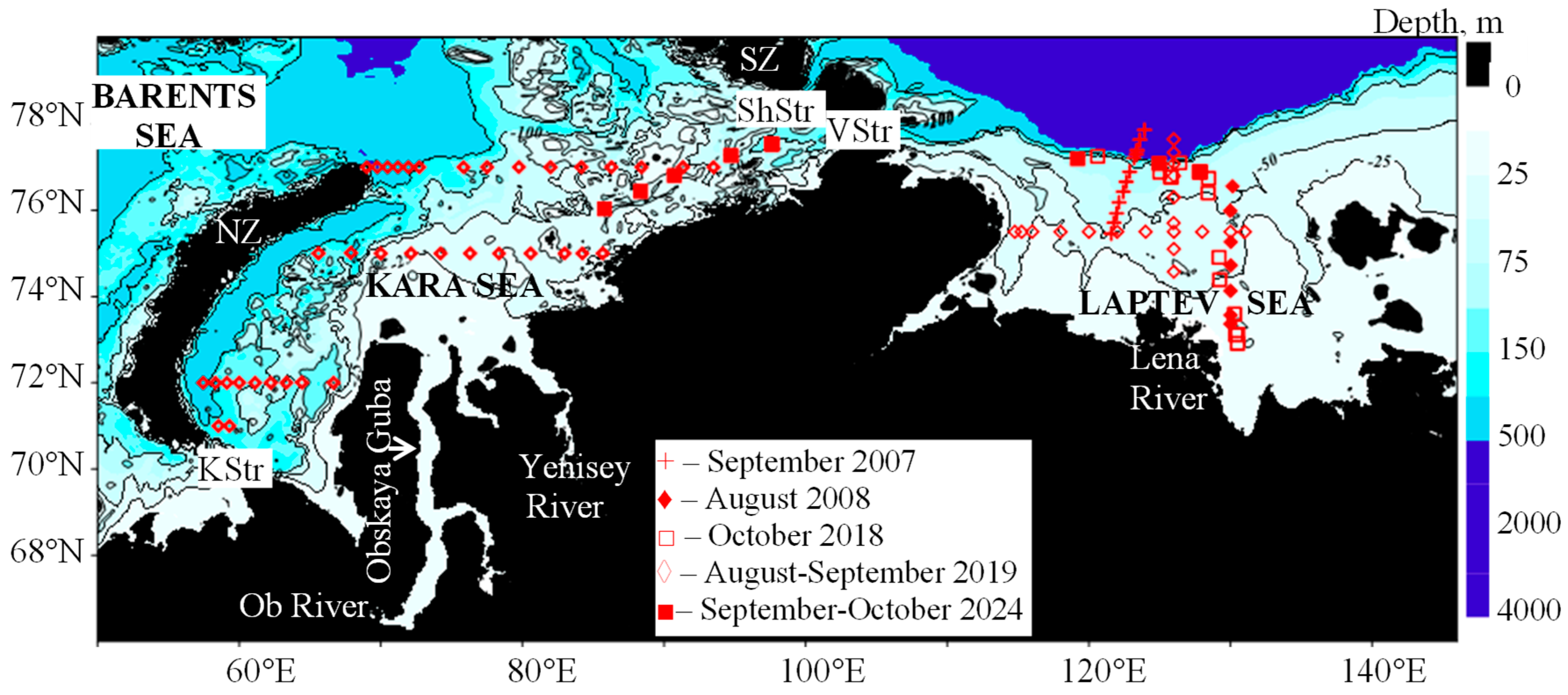
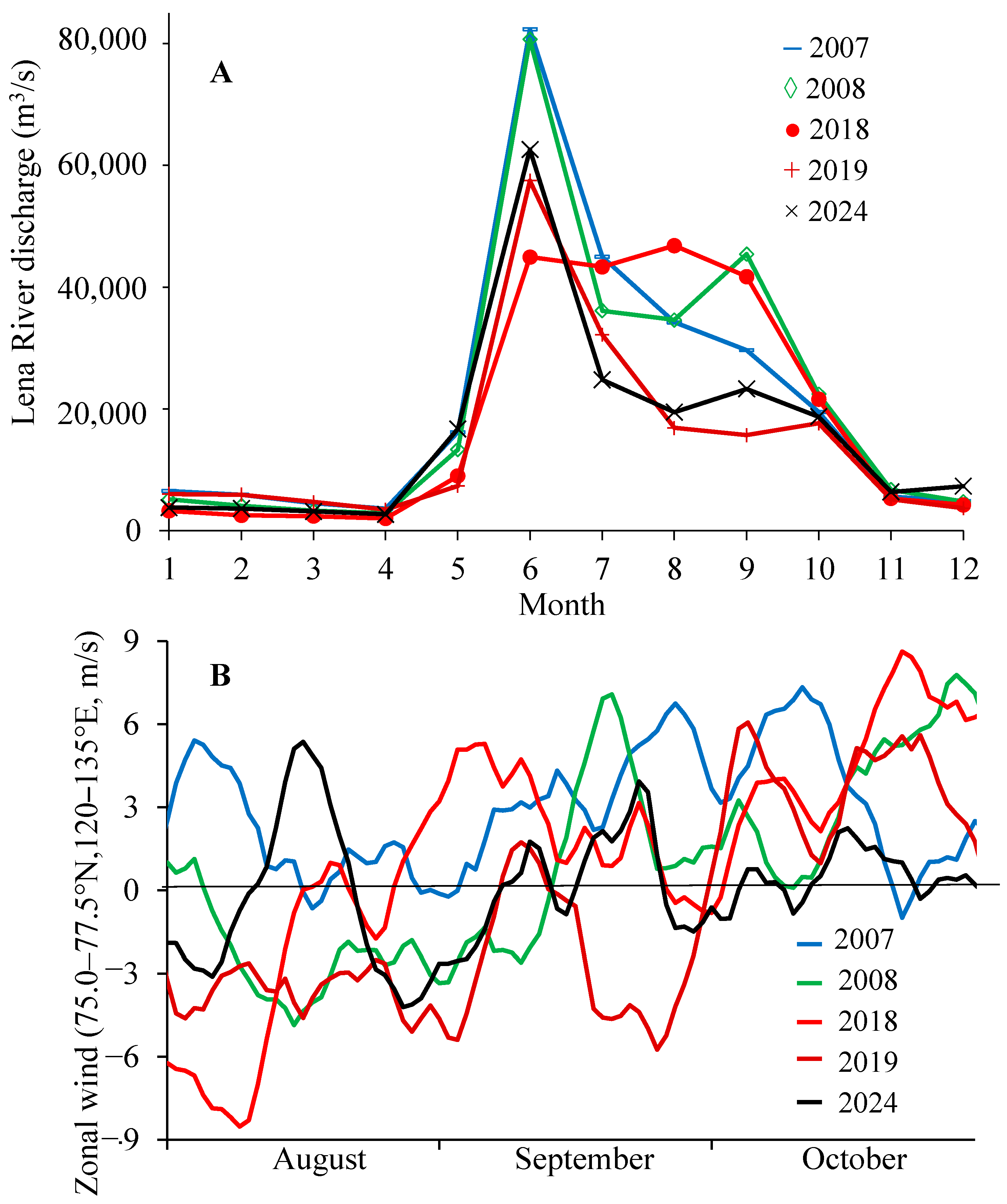
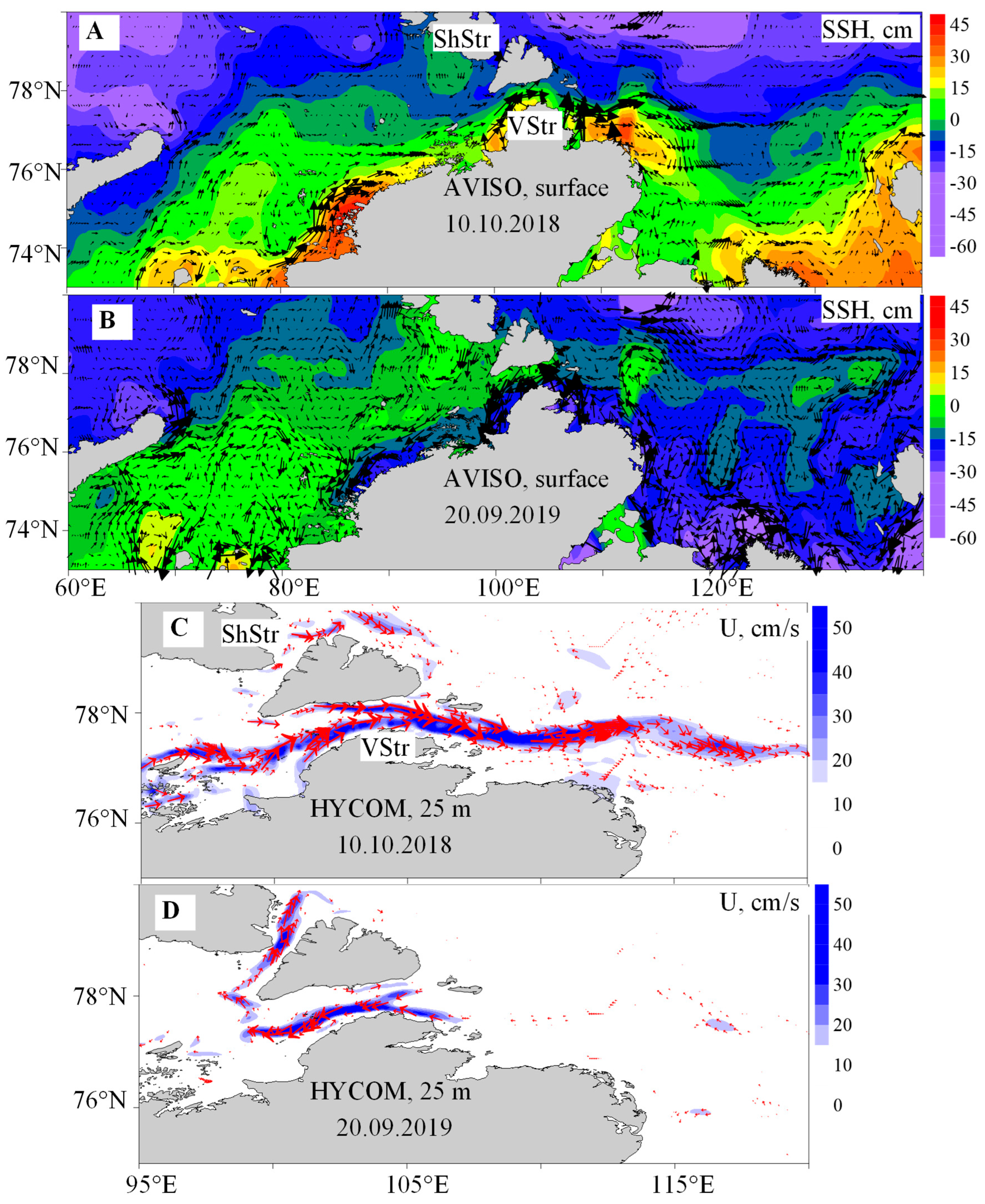
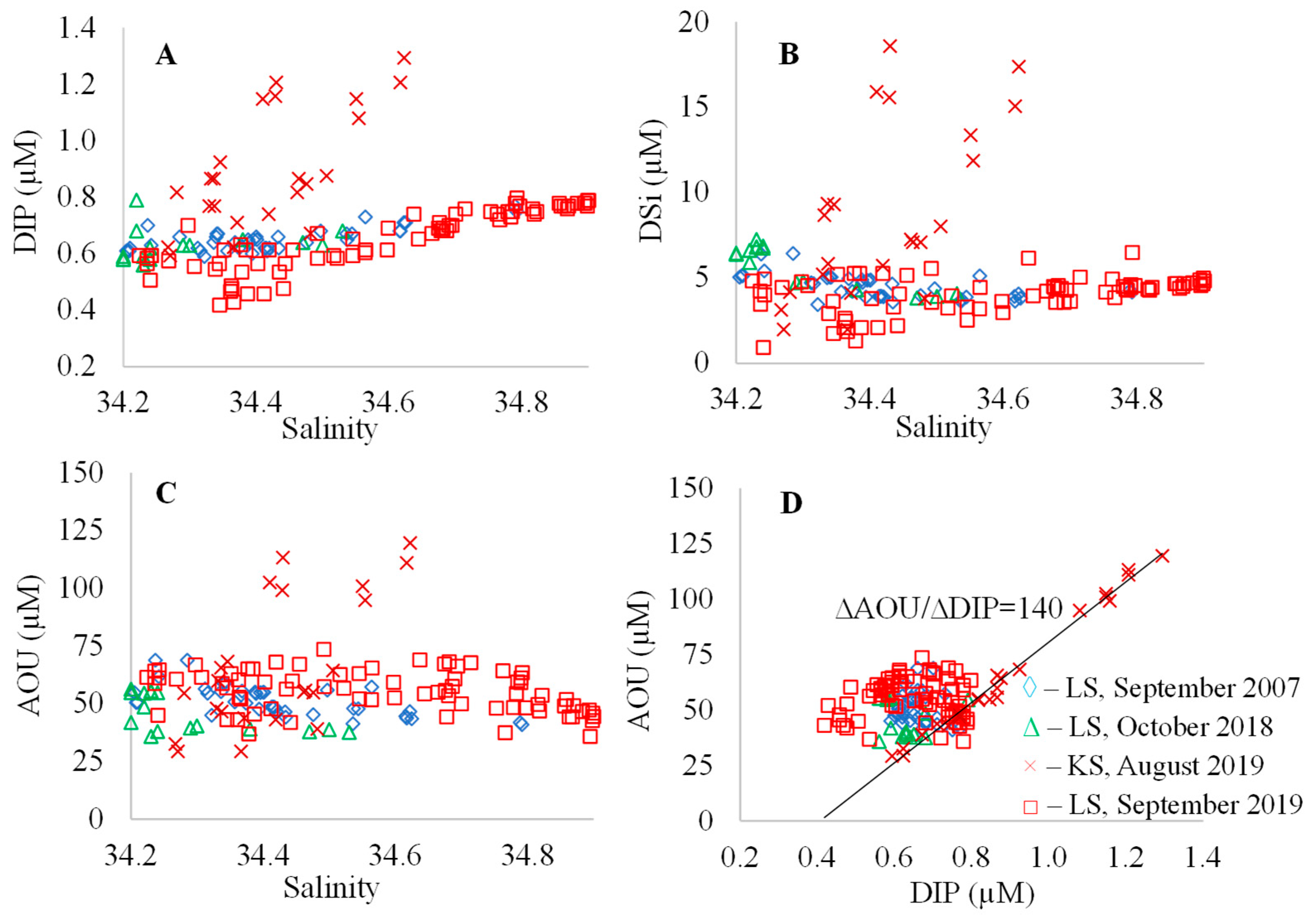

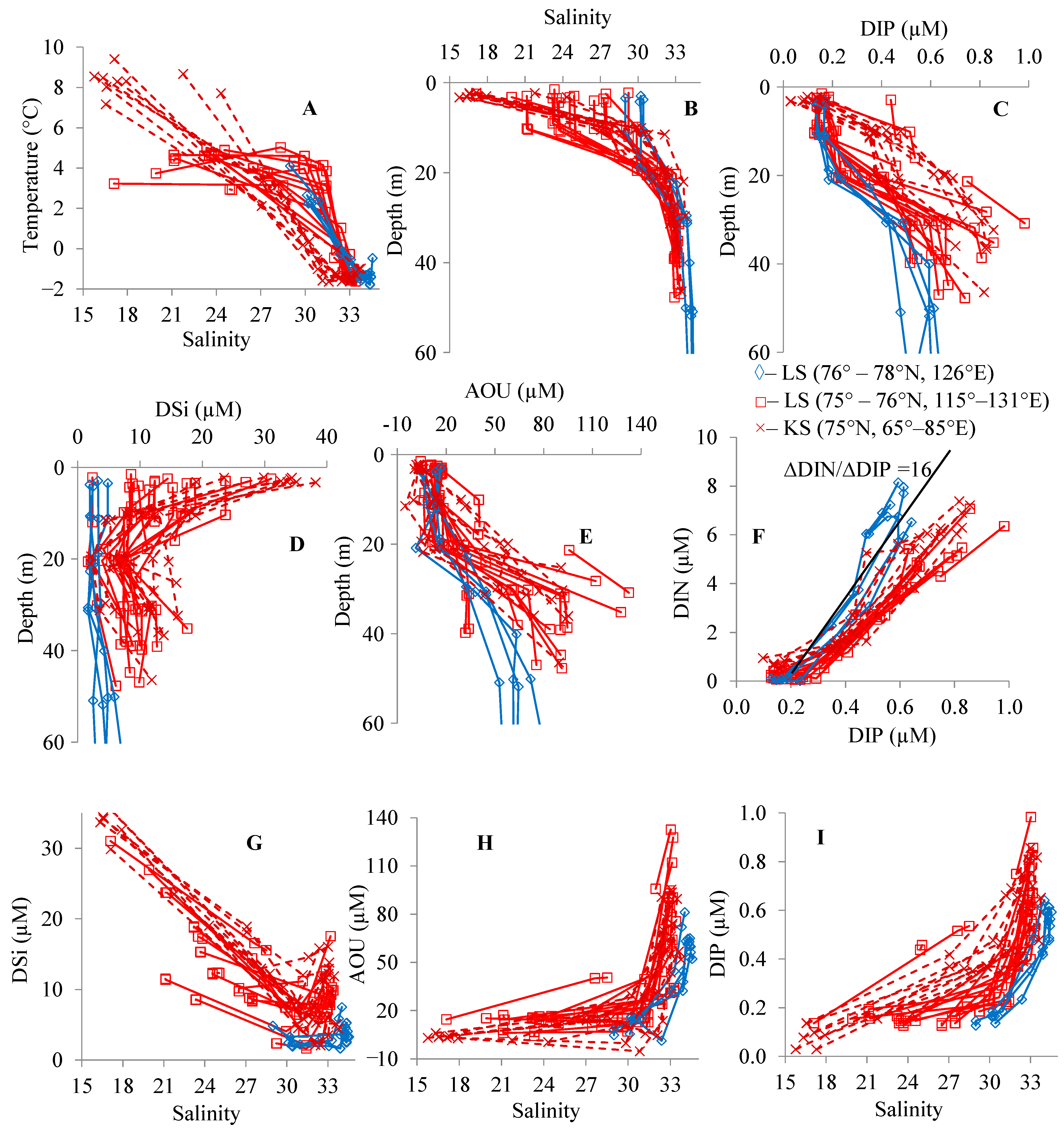
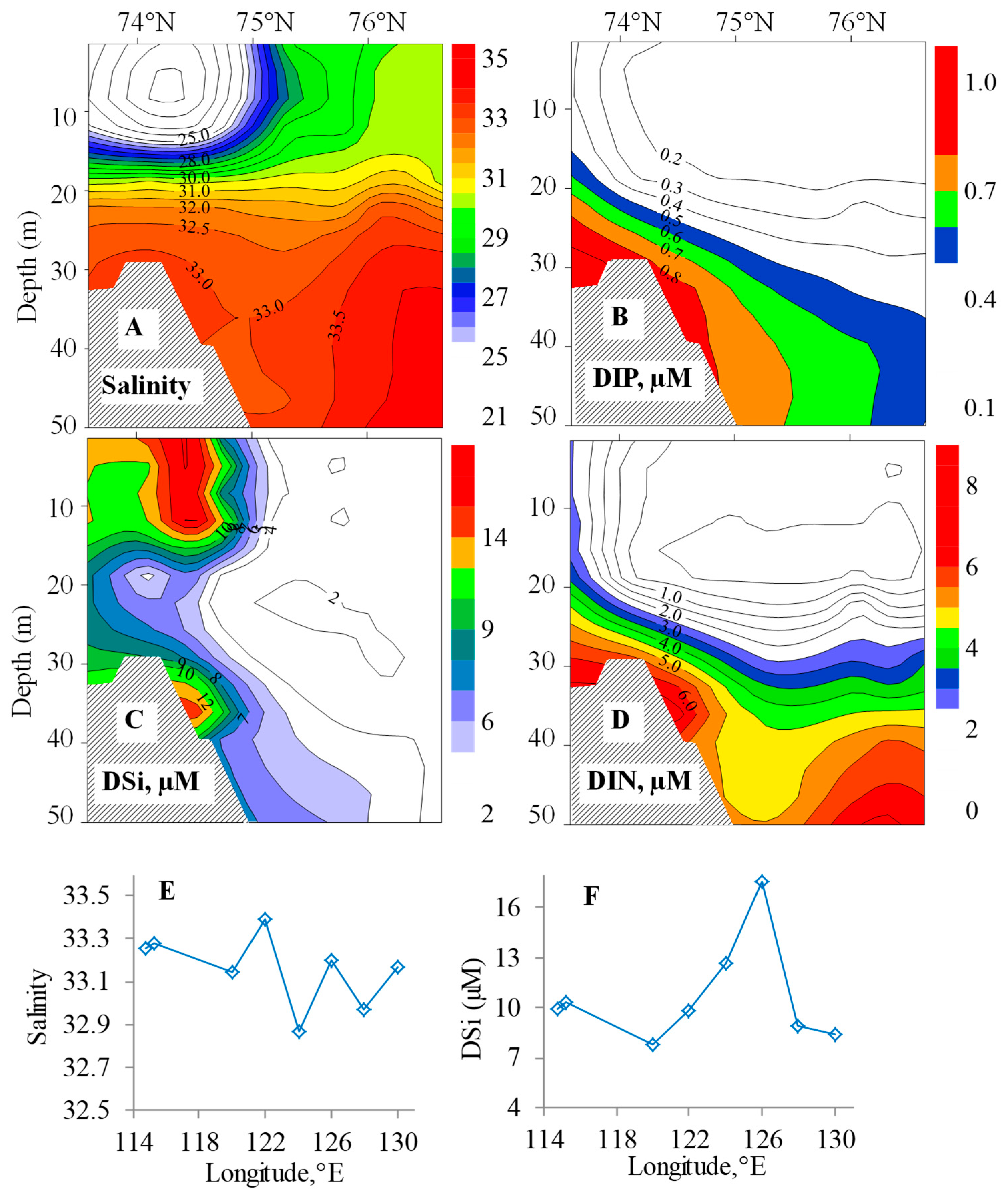
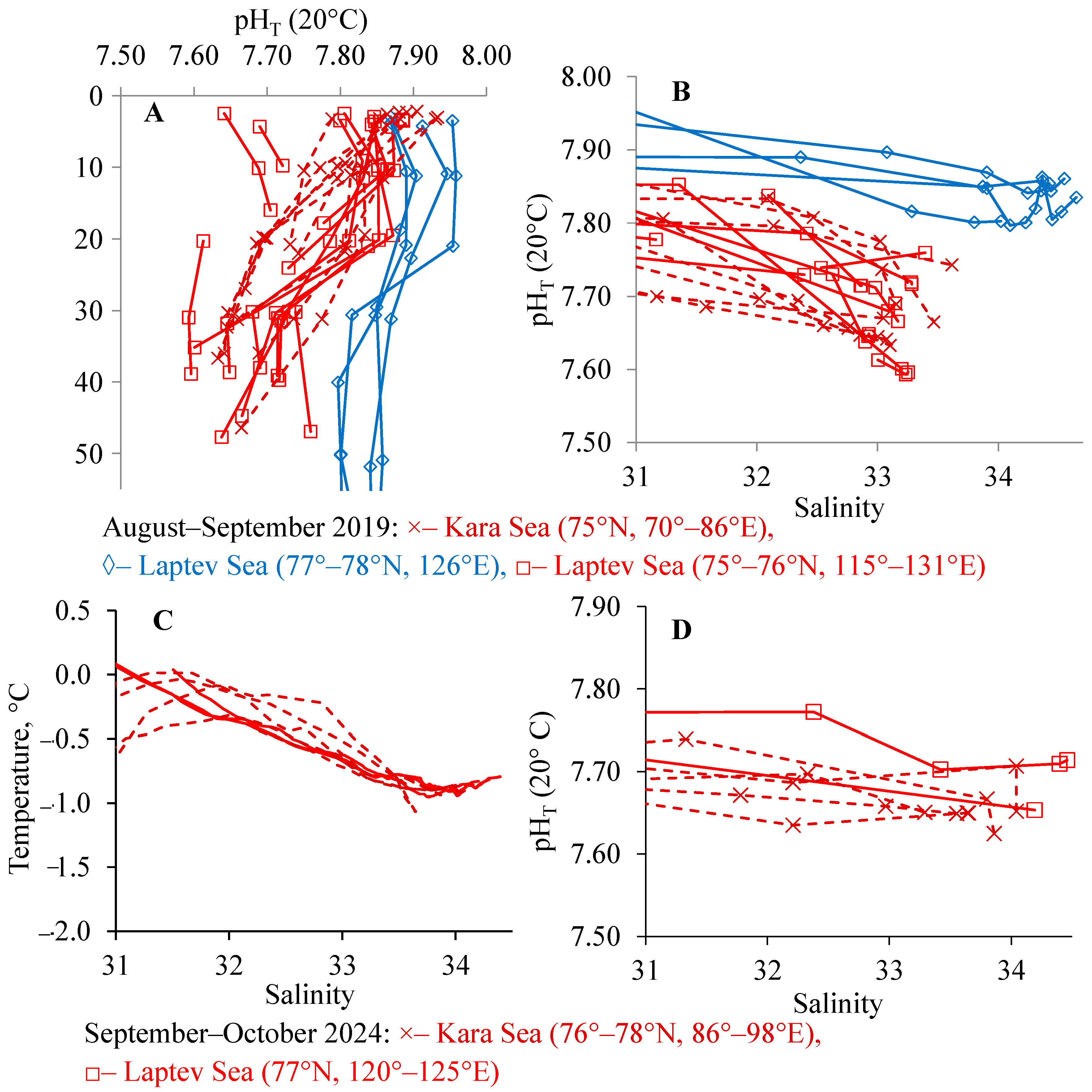
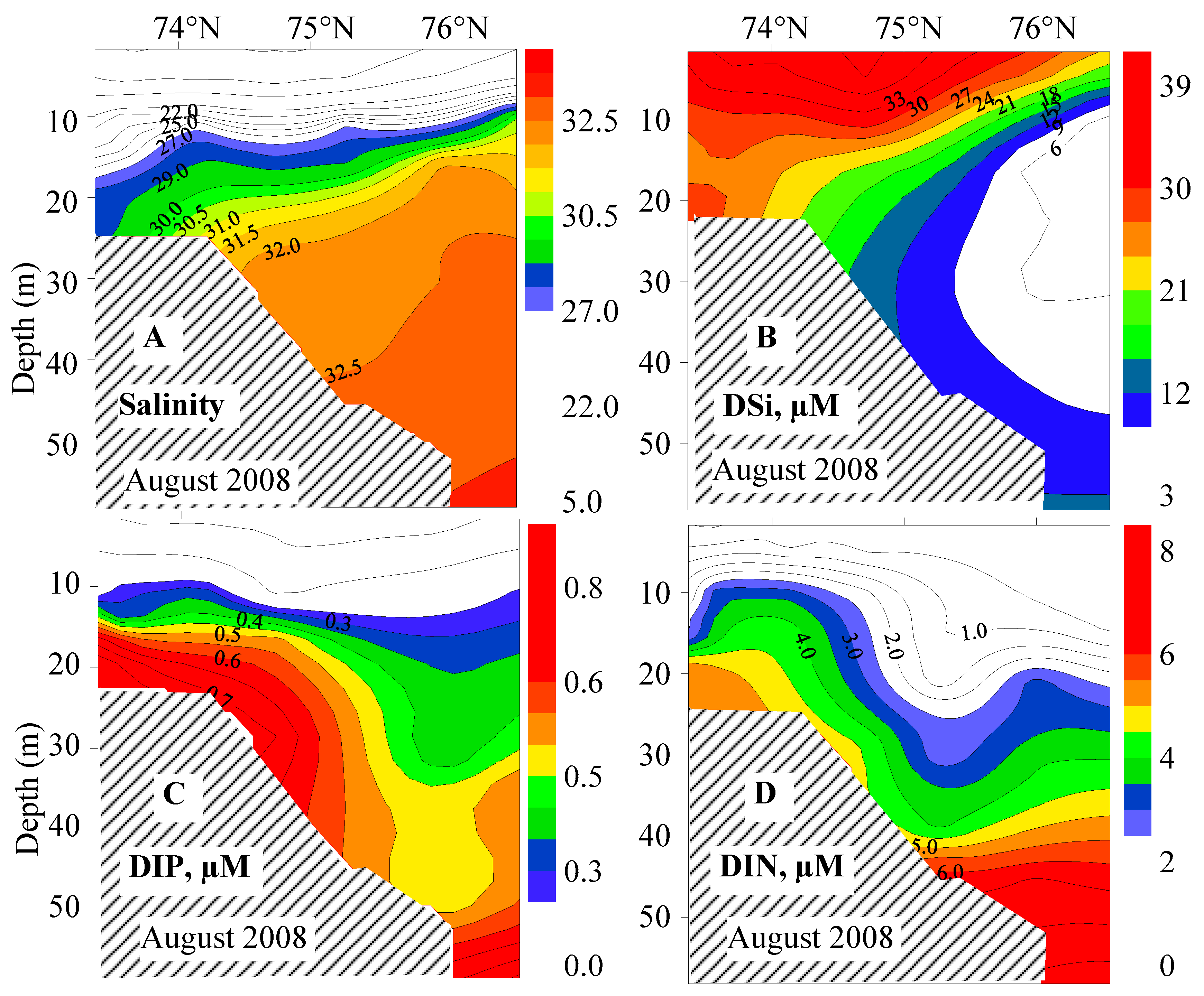
Disclaimer/Publisher’s Note: The statements, opinions and data contained in all publications are solely those of the individual author(s) and contributor(s) and not of MDPI and/or the editor(s). MDPI and/or the editor(s) disclaim responsibility for any injury to people or property resulting from any ideas, methods, instructions or products referred to in the content. |
© 2025 by the authors. Licensee MDPI, Basel, Switzerland. This article is an open access article distributed under the terms and conditions of the Creative Commons Attribution (CC BY) license (https://creativecommons.org/licenses/by/4.0/).
Share and Cite
Andreev, A.; Pipko, I.; Pugach, S.; Semiletov, I. Impact of Kara Sea Shelf Water on Seawater Parameters in Subsurface Layer of Laptev Sea. J. Mar. Sci. Eng. 2025, 13, 1522. https://doi.org/10.3390/jmse13081522
Andreev A, Pipko I, Pugach S, Semiletov I. Impact of Kara Sea Shelf Water on Seawater Parameters in Subsurface Layer of Laptev Sea. Journal of Marine Science and Engineering. 2025; 13(8):1522. https://doi.org/10.3390/jmse13081522
Chicago/Turabian StyleAndreev, Andrey, Irina Pipko, Svetlana Pugach, and Igor Semiletov. 2025. "Impact of Kara Sea Shelf Water on Seawater Parameters in Subsurface Layer of Laptev Sea" Journal of Marine Science and Engineering 13, no. 8: 1522. https://doi.org/10.3390/jmse13081522
APA StyleAndreev, A., Pipko, I., Pugach, S., & Semiletov, I. (2025). Impact of Kara Sea Shelf Water on Seawater Parameters in Subsurface Layer of Laptev Sea. Journal of Marine Science and Engineering, 13(8), 1522. https://doi.org/10.3390/jmse13081522





